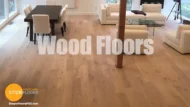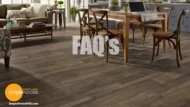Hardwood floors add timeless elegance and warmth to any home. They’re a favorite for their beauty, durability, and ability to complement nearly any interior style. With proper care, they can last for decades and age gracefully. But over time, even the best-maintained floors can lose their luster. Daily wear, furniture movement, pet claws, and UV exposure all take a toll.
Scratches, fading, and wear marks indicate that your floors may need attention. You might also notice dullness or an uneven sheen in high-traffic areas. Fortunately, you don’t always need to replace your floors. In many cases, a simple floor refinish can restore their original beauty. Refinished floors can dramatically improve a space without the expense of full replacement.
Knowing when to refinish or replace is essential. This guide will help you make the right decision.
When to Refinish Your Hardwood Floors
Not every scratch or scuff means it’s time to replace your floors. In many cases, a hardwood refinish will bring them back to life. Here are signs your floors are ready for a refresh:
-
Surface scratches and dullness: If your floors look worn but the damage is superficial, they’re a good candidate for sanding and finishing.
-
Fading from sunlight: UV exposure can dull or discolor floors, which a floor refinishing can correct.
-
Small water stains: Light water marks can often be removed through a hardwood refinish process.
-
Loss of sheen: A sand and seal may restore clarity and shine if your floor’s finish looks cloudy or uneven.
According to the National Wood Flooring Association (NWFA), hardwood floors can be refinished up to 10 times in their lifetime, depending on the thickness of the wood. On average, hardwood floors should be refinished every 7 to 10 years, but high-traffic homes may need it more often.
Refinish vs Replace: Knowing the Difference
Replacing hardwood floors is a major project—and a major expense. If your existing wood is structurally sound, refinishing is often a more cost-effective and environmentally friendly choice.
Choose to refinish when:
-
The wood is still thick enough for sanding.
-
Damage is mostly cosmetic—scratches, scuffs, or discoloration.
-
The boards are not warped or severely water damaged.
-
You want to change the finish color without changing the floor entirely.
Choose to replace when:
-
The flooring has deep gouges, rot, or water damage.
-
Multiple sanding jobs have already been done, and not enough wood remains.
-
You want to change the wood species or layout.
-
Subfloor issues require full replacement anyway.
On average, refinishing hardwood floors costs $3 to $8 per square foot, while replacing them can run $8 to $15 per square foot or more, depending on material and labor.
DIY Refinish Tips for Handy Homeowners
Thinking about trying a sand and seal job yourself? It’s doable, especially if you have experience with power tools and a small area to refinish. Here are some helpful tips:
-
Rent the right equipment: You’ll need a drum sander for the main floor and an edge sander for the corners.
-
Use multiple grits: Start with coarse grit to remove old finish, then gradually move to finer grits to smooth the surface.
-
Vacuum thoroughly: Dust from sanding can cause problems with finish adhesion. Clean between every sanding stage.
-
Apply sealer evenly: Once you sand the floor, apply a wood sealer or stain and let it dry completely.
-
Finish with care: Apply 2-3 coats of polyurethane, allowing proper drying time between each coat.
DIY refinishing works best for small areas or rooms with minor surface damage. It also gives you the flexibility to work at your own pace. However, it’s a labor-intensive project, and mistakes can be costly.
When to Hire Professionals for Floor Refinish Projects
While a do-it-yourself hardwood refinish can save money, hiring professionals brings peace of mind and polished results. There are several situations where professional sand and finish services are well worth the investment:
-
Large or open spaces: Refinishing big areas requires more powerful equipment and expertise.
-
Historic or valuable floors: Older floors may need careful handling to preserve their character.
-
Inexperience with sanding tools: Drum sanders are powerful and can easily gouge wood if used improperly.
-
Desire for a flawless finish: Professionals deliver smoother results and even coatings.
-
Time constraints: A professional crew can typically refinish a home in 2-3 days.
Professional teams also bring industry-grade equipment and products that often aren’t available to consumers. They’re also skilled at choosing the right sand and seal process based on your wood type and floor condition.
According to HomeAdvisor, homeowners pay an average of $1,200 to $2,400 for professional hardwood floor refinishing. While that may seem like a significant cost, the result can increase your home’s value and appeal.
Benefits of Refinishing Over Replacing
If you’re still debating whether to refinish or replace, consider the following benefits of refinishing: 
-
Cost savings: Refinishing can be 40% to 60% less expensive than replacement.
-
Less disruption: A floor refinish takes less time and doesn’t require tearing out old flooring.
-
Eco-friendly: Sanding and sealing existing wood floors keeps materials out of landfills.
-
Customization: Refinishing allows you to change stain colors, sheen levels, and finishes.
-
Increased home value: A well-maintained hardwood floor is a major selling point for buyers.
In fact, the National Association of Realtors reports that refinishing hardwood floors recovers 147% of its cost at resale, making it one of the most valuable home improvement projects.
How Often Should You Sand and Finish Your Floors?
This depends on traffic, pets, and how well you care for your floors. A hardwood floor can be sanded and refinished every 7 to 10 years. However, homes with kids, pets, or heavy foot traffic may need it every 3 to 5 years.
If you’re unsure, test your floor’s finish. Pour a small amount of water on a high-traffic spot. If it beads, your finish is still good. If it soaks in, it’s time to refinish.
Remember that hardwood floors can only be sanded a limited number of times. Most solid hardwood floors can withstand 4 to 10 refinishes in their lifetime, depending on the thickness of the planks and how aggressively they are sanded.
Bring New Life to Old Floors
Hardwood floors are one of the most durable and beautiful flooring options available. But like anything else in your home, they need occasional care to stay at their best. Everyday foot traffic, spills, and sunlight can gradually wear down the finish and dull the wood’s natural beauty. Don’t assume replacement is the only option when your floors show signs of wear. Often, a floor refinishing or professional sand and seal job is all it takes to bring them back to life.
A proper hardwood refinish can remove surface damage, restore color, and renew the protective coating. Whether you tackle the project yourself or hire professionals, the results can be stunning. Refinished hardwood floors add value, comfort, and beauty to your home while protecting your original investment.
If you’re considering a hardwood floor refinish or have questions about sand and finish services in Portland, our team at Simple Floors PDX is here to help. We’ll guide you through the process and ensure your floors look better than ever.









